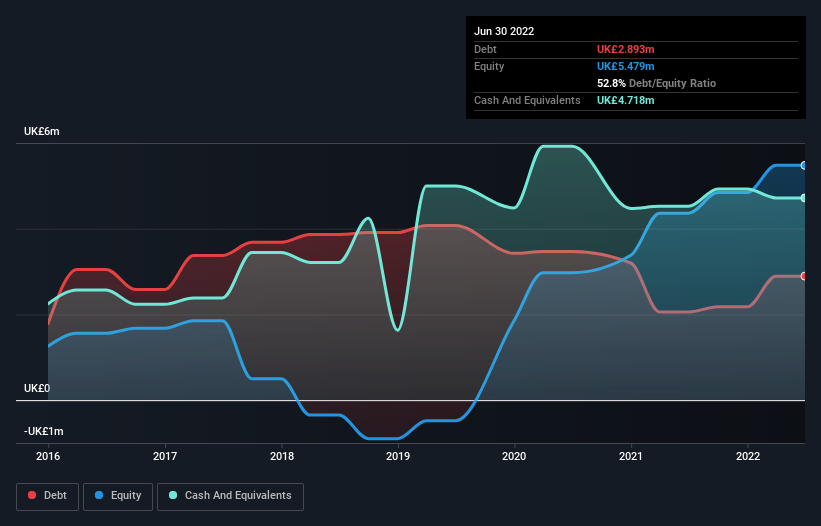David Iben put it well when he said, 'Volatility is not a risk we care about. What we care about is avoiding the permanent loss of capital.' So it might be obvious that you need to consider debt, when you think about how risky any given stock is, because too much debt can sink a company. We can see that MobilityOne Limited (LON:MBO) does use debt in its business. But the more important question is: how much risk is that debt creating?
When Is Debt Dangerous?
Debt assists a business until the business has trouble paying it off, either with new capital or with free cash flow. In the worst case scenario, a company can go bankrupt if it cannot pay its creditors. However, a more usual (but still expensive) situation is where a company must dilute shareholders at a cheap share price simply to get debt under control. Of course, debt can be an important tool in businesses, particularly capital heavy businesses. The first step when considering a company's debt levels is to consider its cash and debt together.
Check out our latest analysis for MobilityOne
What Is MobilityOne's Net Debt?
The image below, which you can click on for greater detail, shows that at June 2022 MobilityOne had debt of UK£2.89m, up from UK£2.06m in one year. However, it does have UK£4.72m in cash offsetting this, leading to net cash of UK£1.82m.

How Healthy Is MobilityOne's Balance Sheet?
The latest balance sheet data shows that MobilityOne had liabilities of UK£7.05m due within a year, and liabilities of UK£344.0k falling due after that. On the other hand, it had cash of UK£4.72m and UK£3.18m worth of receivables due within a year. So it can boast UK£510.4k more liquid assets than total liabilities.
This surplus suggests that MobilityOne has a conservative balance sheet, and could probably eliminate its debt without much difficulty. Simply put, the fact that MobilityOne has more cash than debt is arguably a good indication that it can manage its debt safely.
The modesty of its debt load may become crucial for MobilityOne if management cannot prevent a repeat of the 47% cut to EBIT over the last year. Falling earnings (if the trend continues) could eventually make even modest debt quite risky. The balance sheet is clearly the area to focus on when you are analysing debt. But you can't view debt in total isolation; since MobilityOne will need earnings to service that debt. So when considering debt, it's definitely worth looking at the earnings trend. Click here for an interactive snapshot.
Finally, a company can only pay off debt with cold hard cash, not accounting profits. MobilityOne may have net cash on the balance sheet, but it is still interesting to look at how well the business converts its earnings before interest and tax (EBIT) to free cash flow, because that will influence both its need for, and its capacity to manage debt. In the last three years, MobilityOne's free cash flow amounted to 24% of its EBIT, less than we'd expect. That's not great, when it comes to paying down debt.
Summing Up
While we empathize with investors who find debt concerning, you should keep in mind that MobilityOne has net cash of UK£1.82m, as well as more liquid assets than liabilities. So we are not troubled with MobilityOne's debt use. The balance sheet is clearly the area to focus on when you are analysing debt. However, not all investment risk resides within the balance sheet - far from it. We've identified 4 warning signs with MobilityOne (at least 2 which are significant) , and understanding them should be part of your investment process.
If you're interested in investing in businesses that can grow profits without the burden of debt, then check out this free list of growing businesses that have net cash on the balance sheet.
New: Manage All Your Stock Portfolios in One Place
We've created the ultimate portfolio companion for stock investors, and it's free.
• Connect an unlimited number of Portfolios and see your total in one currency
• Be alerted to new Warning Signs or Risks via email or mobile
• Track the Fair Value of your stocks
Have feedback on this article? Concerned about the content? Get in touch with us directly. Alternatively, email editorial-team (at) simplywallst.com.
This article by Simply Wall St is general in nature. We provide commentary based on historical data and analyst forecasts only using an unbiased methodology and our articles are not intended to be financial advice. It does not constitute a recommendation to buy or sell any stock, and does not take account of your objectives, or your financial situation. We aim to bring you long-term focused analysis driven by fundamental data. Note that our analysis may not factor in the latest price-sensitive company announcements or qualitative material. Simply Wall St has no position in any stocks mentioned.
About AIM:MBO
MobilityOne
An investment holding company, provides e-commerce infrastructure payment solutions and platforms through its proprietary technology solutions in Malaysia.
Slight risk and slightly overvalued.
Market Insights
Community Narratives



